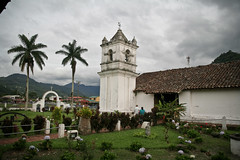globalwanderer.net
not all who wander are lost
Category Archives: event
Lesnia’s scars
I remember very powerfully the tender feelings I had while I gently wiped bits of blood and gravel from the gashes on Lesnia’s leg.
When I had a car, I used to bring Lesnia and several other members of her family over to our church on Sundays. Afterward we had all sorts of fun adventures. We’d get pizza or KFC, visit a park, or fly kites.
Lesnia had fallen and slid while scrambling up the steep hill at Peace Park, scraping open a few large gashes on her leg. As far as my medical knowledge goes, I knew the scrape should be cleaned of dirt and washed so it didn’t get infected. I used rubbing alcohol and daubed it with a cotton ball. I watched as she cringed, squeezing back tears as the alcohol sent the stinging pain searing through her body. Continue reading
The Orosi Valley
 A few weeks ago, I took a Saturday morning to bike the Orosi Valley loop, a beautiful scenic road to the east of the greater metropolitan area (the San Jose capital and its outlying cities). It winds through lush green coffee fields, old colonial churches, follows the Reventazón river and crosses the dam, and passes through some beautiful small towns and some breathtaking overlooks.
A few weeks ago, I took a Saturday morning to bike the Orosi Valley loop, a beautiful scenic road to the east of the greater metropolitan area (the San Jose capital and its outlying cities). It winds through lush green coffee fields, old colonial churches, follows the Reventazón river and crosses the dam, and passes through some beautiful small towns and some breathtaking overlooks.
Check out a mix of photos from different trips around the loop: the Ujarrás Ruins (1693), the Orosí colonial church (1743), photos from along the route itself, and some pictures with awesome people I made the trips with. Continue reading
Cerro Chirripó – Highest point in Costa Rica
 As I write this I am still wincing painfully from sore leg muscles when I climb stairs and stand up from sitting as a result of my most recent adventure – climbing Mount Chirripó, Costa Rica’s highest mountain. Climbing this 12,533-foot mountain up into high-altitude tropical climate was one of my two most recent adventures involving physically taxing undertakings in order to experience the raw natural beauty of Costa Rica that has gripped me and held me captive since I first arrived here. A few weeks ago, I took a Saturday to bike the Orosi Valley loop, a beautiful scenic road to the east of the greater metropolitan area (the San Jose capital and its outlying cities). It winds through lush green coffee fields, old colonial churches, follows the Reventazón river and crosses the dam, through some beautiful small towns and some breathtaking overlooks. Both experiences were physically pretty exhausting, but incredibly beautiful. And climbing Chirripó was the more difficult and culturally significant of the two. Continue reading
As I write this I am still wincing painfully from sore leg muscles when I climb stairs and stand up from sitting as a result of my most recent adventure – climbing Mount Chirripó, Costa Rica’s highest mountain. Climbing this 12,533-foot mountain up into high-altitude tropical climate was one of my two most recent adventures involving physically taxing undertakings in order to experience the raw natural beauty of Costa Rica that has gripped me and held me captive since I first arrived here. A few weeks ago, I took a Saturday to bike the Orosi Valley loop, a beautiful scenic road to the east of the greater metropolitan area (the San Jose capital and its outlying cities). It winds through lush green coffee fields, old colonial churches, follows the Reventazón river and crosses the dam, through some beautiful small towns and some breathtaking overlooks. Both experiences were physically pretty exhausting, but incredibly beautiful. And climbing Chirripó was the more difficult and culturally significant of the two. Continue reading
Visitors from Colombia
Earlier this month four youth from a church in Armenia, Colombia, completed their visit to Costa Rica as missionaries-in-training. During their time here they served in various ministries through the church I’m a part of (Amistad Internacional in San Francisco de Dos Ríos). They plugged right into the church and helped out tirelessly for about two weeks at our church VBS activities and different ministries members of our church are involved in (Funda Vida, YWAM, Latin Link in Los Guidos, Edutecnología, and a young church in Paraíso, Cartago). Each visiting missionary was placed with a family from the church while they were here. Continue reading
